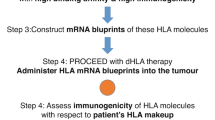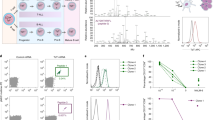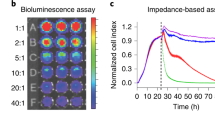Abstract
THERE is a pressing need in medicine for cytotoxic agents with tissue specificity. It may be possible to produce such agents by conjugating cytotoxic materials, themselves lacking inherent specificity, to antibodies directed against surface antigens peculiar to target cells. Various agents, including cytotoxic drugs1–7, radioactive materials8, radiosensitising agents9 and enzymes10–11 have been covalently coupled to antitumour antibodies in attempts to produce such antitumour agents but so far these have not consistently produced cures in tumour-bearing animals. We, like others12–16, have chosen to use diphtheria toxin because we consider that the paucity of tumour-specific antigens, accentuated, perhaps, by their restricted accessibility in solid tumours, necessitates the use of the most potent cytotoxins available.
This is a preview of subscription content, access via your institution
Access options
Subscribe to this journal
Receive 51 print issues and online access
$199.00 per year
only $3.90 per issue
Buy this article
- Purchase on Springer Link
- Instant access to full article PDF
Prices may be subject to local taxes which are calculated during checkout
Similar content being viewed by others
References
Mathé, G., Tran Ba Loc & Bernard, J. C. C. hêbd. Acad. Sci. (Paris) 246, 1626–1628 (1958).
Rowland, G. F., O'Neill, G. J. & Davies, D. A. L. Nature 255, 487–488 (1975).
Rowland, G. F., Eur. J. Cancer 13, 593–596 (1977).
Hurwitz, E., Maron, R., Arnon, R. & Sela, M. Cancer Biochem. Biophys. 1, 197–202 (1976).
Robinson, D. A., Whitley, J. M. & Harding, N. G. L. Biochem. Soc. Trans. 1, 722–729 (1973).
Froese, G., Linford, J. H., Berezi, I., Sehon, A. H. & Israels, L. G. AACR Abst. No.120 (1976).
Burstein, S. & Knapp, R. J. med. Chem. 20, 950–952 (1977).
Ghose, T., Guclu, A., Tai, J., MacDonald, A. S., Norvell, S. T. & Aquino, J. Cancer 36, 1646–1657 (1975).
Hawthorne, M. F., Wiersema, R. J. & Takasugi, M. J. med. Chen. 15, 449–452 (1972).
Shearer, W. T. et al. Int. J. Cancer 14, 539–547 (1974).
Flickinger, R. A. & Trost, S. R. Eur. J. Cancer 12, 159–160 (1976).
Moolten, F. L., Capparell, N. J. & Cooperband, S. R. J. natn. Cancer Inst. 49, 1057–1062 (1972).
Moolten, F. L., Capparell, N. J. & Zajdel, S. H. J. natn. Cancer Inst. 55, 709–712 (1975).
Moolten, F. L., Capparell, N. J., Zajdel, S. H. & Cooperband, S. R. J. natn. Cancer Inst. 55, 473–477 (1975).
Moolten, F. L., Zajdel, S. & Cooperband, S. Ann. N. Y. Acad. Sci. 277, 690–699 (1976).
Philpott, G. W., Bower, R. J. & Parker, C. W. Surgery 73, 928–935 (1973).
Boquet, P. & Pappenheimer, A. M. J. biol. Chem. 251, 5770–5778 (1976).
Saelinger, C. B., Bonventre, P. F., Ivins, B. & Straus, D. Infect. Immun. 14, 742–751 (1976).
Kandel, J., Collier, R. J. & Chung, D. W. J. biol. Chem. 249, 2088–2096 (1974).
Woiwod, A. J. et al. Transplantation 10, 173–186 (1970).
Bolton, A. E. & Hunter, W. M. Biochem. J. 133, 529–539 (1973).
Collier, R. J. & Kandel, J. J. biol. Chem. 246, 1496–1503 (1971).
Davies, D. A. L. & O'Neill, G. J. Br. J. Cancer 28, suppl., 285–298 (1973).
Davies, D. A. L. Cancer Res. 34, 3040–3043 (1974).
Rubens, R. D. & Dulbecco, R. Nature 248, 81–82 (1974).
Ghose, T., Guclu, A. & Tai, J. J. natn. Cancer Inst. 55, 1353–1357 (1975).
O'Neill, G. J., Pearson, B. A. & Davies, D. A. L. Immunology 28, 323–329 (1975).
Unanue, E. R., Perkins, W. D. & Karnovsky, M. J. J. Immun. 108, 569–572 (1972).
Ross, W. C. J. Chem. biol. Interactions 10, 169–172 (1975).
Ross, W. C. J. Chem. biol. Interactions 11, 139–143 (1975).
Kim, K. & Groman, N. B. J. Bact. 90, 1552–1556 (1965).
Thorpe, P. E. & Knight, S. C. J. immun. Meth. 5, 387–404 (1974).
Author information
Authors and Affiliations
Rights and permissions
About this article
Cite this article
THORPE, P., Ross, W., CUMBER, A. et al. Toxicity of diphtheria toxin for lymphoblastoid cells is increased by conjugation to antilymphocytic globulin. Nature 271, 752–755 (1978). https://doi.org/10.1038/271752a0
Received:
Accepted:
Published:
Issue Date:
DOI: https://doi.org/10.1038/271752a0
This article is cited by
-
Tumor regression with regional distribution of the targeted toxin TF-CRM107 in patients with malignant brain tumors
Nature Medicine (1997)
-
Plant toxins in drug targeting
Plant Molecular Biology Reporter (1984)
Comments
By submitting a comment you agree to abide by our Terms and Community Guidelines. If you find something abusive or that does not comply with our terms or guidelines please flag it as inappropriate.



